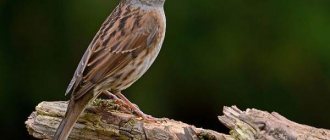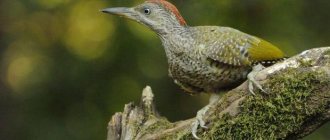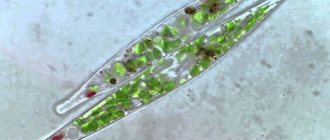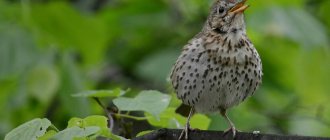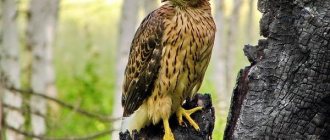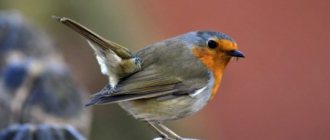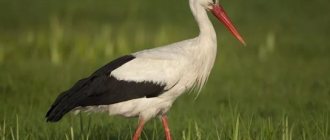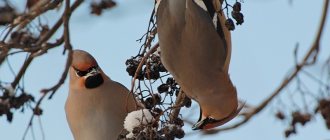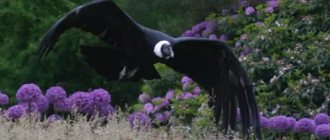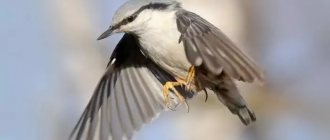Cities and semi-wild places in the Moscow region are important or even main habitats for some bird species. In this unusual environment, which is a combination of human genius and the forces of nature, a unique habitat has been created for bird species rarely found in other regions of the country.
Avifauna moves closer to human settlements by the arrival of the cold season of the year. Migrant species are found in parks; they are “city dwellers” in winter and return to nature when it gets warmer. These species do not need to fly to the warm South, because in cities it is not as cold as in the forest. Finches, goldfinches, wagtails, and cuckoos visit cities like village relatives visit people.
White stork
Large marsh bird. The plumage is white, the tips of the wings are black, the beak and legs are orange-red. The average weight of individuals is 3–4 kg. Inhabits swamps, canals, meadows and river banks.
It feeds on snakes, frogs, and fish. Does not disdain lizards. May eat small mammals or small birds. The white stork migrates from Europe to Africa for the winter.
Black stork
Similar in characteristics to the white stork. The exception is the color of the bird - it is almost all black (back, head, chest and tail). The ventral part is white. Average weight is about 3 kg. The bird lives throughout Eurasia. More often found in swamps and rivers. Arrives in Europe in mid-spring (late March - early April).
It feeds on fish, mice, insects, and mollusks. Can catch snakes and lizards.
The bird is rare. Listed in the Red Book of the Russian Federation and the CIS.
Deaf cuckoo
The bird has the standard coloration of the common cuckoo. The plumage of the male is light gray (ashy) in color. The female is brighter. She has visible red spots.
The deaf cuckoo lives in deciduous and coniferous forests and forest-tundra zones. Migration takes place in the fall in an easterly direction. Winters in the Philippines.
The bird's diet includes caterpillars, insects, and beetles. Eats butterflies, flies, spiders and chafers. In times of hunger, it can attack the offspring of other birds living nearby.
Common lentils
A small bird, similar in size to a sparrow. The head of the lentil is red, the plumage is gray-brown, and the belly is white. It breeds in Eurasia, and in winter flies to the southern part of East Asia.
Lives in densely growing forests and bushes. Can be found at the edge of a forest or near a river. It is difficult to see the bird - it is well camouflaged. The lentils give out a ringing whistle.
It feeds mainly on plant foods - berries, seeds. Rarely eats insects. Flies to wintering grounds in mid-August (from Europe to the east). Arrives in May.
Nightingale
Songbird. The nightingale is difficult to spot in the foliage. The feathered one is distinguished by its beautiful, melodic singing. The male and female have almost the same color: the abdomen is gray-white, the upper body and head are smoky brown, sandy.
Nightingales live in forest areas, in bushes, and in city parks. They feed on beetles and worms. They love spiders, caterpillars and ants. Collect seeds and berries.
Common cuckoo
A medium-sized bird (up to 600–700 g). The color is brown interspersed with dark and light shades. The cuckoo is famous for its lack of “maternal instinct.” She lays her eggs on other birds (she does not hatch them herself).
Lives in forests and swamps. It feeds on lizards, caterpillars, and beetles. Might eat a mouse.
The bird doesn't sing. She makes the familiar “ku-ku” sounds to everyone. The habitat covers many zones - from deserts to the Atlantic. Migratory bird. Winters in Africa.
Great cormorant
Large fishing bird. It has a long neck and a curved beak. The plumage color is black, the beak is white. The lower part of the body has a lighter shade. Cheeks yellow. Weight from 2 to 3 kg.
The cormorant lives in Europe, Africa, and North America. Lives on the shores of seas and inland waters. Migratory bird. Winters in the south of Crimea.
It feeds on fish (dives 4 m for it), insects and mollusks.
Zhelna
Another name is black woodpecker. Lives in the forests. It has a black color, the head (crest) is red. It feeds on insects (obtains them from tree bark). The voice is loud and melodic (reminiscent of the sound “kru-kru-kru”).
Habitat: forest-steppe of Eurasia. Loves coniferous and mixed forests, deep taiga. In search of food, the bird hollows out trees, getting beetles and larvae.
Hoopoe
Migratory, nesting bird. The representative has a bright color: the head is red, the body with wings is striped (black-brown-white). The breast and lower part have a pinkish tint.
Lives in the Leningrad and Moscow regions, in the taiga zone. Prefers open places with sparse shrubs and grass. Not afraid of people.
It feeds on ants, beetles, and caterpillars. The bird's voice sounds like "whoop-whoop-whoop." The hoopoe also hisses and squeals.
Magpie
The bird looks like a crow. The predominant color is black and white. The tips of the wings are greenish-purple, the belly is white. The tail is long. Lives in all parts of Russia. Settles in forests and parks. Makes chirping sounds.
The bird has high intelligence. She is trainable and can recognize herself in the mirror.
It feeds on forty lizards, beetles, and mice. Does not disdain carrion. Can destroy nests.
Tufted duck
Belongs to the duck family. The bird is small - weighing up to 750 g. Color - black (the male may also have white sides). The beak is short and wide. The sounds of a duck are “gyun-gyun.” It lives in bodies of fresh water: lakes, ponds, rivers.
Arrives in April, as soon as the ice melts. Spends almost all his time in the water. Dives up to 4 m deep. The blackling feeds on small fish, crustaceans, and mollusks. Sometimes eats aquatic plants.
The bird is listed in the Moscow Red Book.
Saker Falcon
Large falcon bird. Colour: The back is brown against a background of contrasting gray feathers. Habitat: plateaus, steppes of southern Siberia and the Baikal region.
The bird hunts small mammals (mice, gophers). Belongs to partially migratory birds. It is considered an endangered species - the balaban is listed in the Red Book.
Waxwing
Refers to songbirds. Outwardly it resembles a sparrow with a crest. Color: gray-pink. There is a yellow stripe along the edge of the tail. Breeds in the taiga forests of Russia, migrates to the southern parts of the continents.
The waxwing is a flocking bird. It feeds on berries, larvae, and insects. Makes trills “svi-ri-ri-ri”.
Snipe
A small dark brown bird with a long stick-shaped beak. The snipe lives in fresh or salty water areas with dense vegetation. Loves marshy areas and wet meadows.
Winters in Southern Europe, migrates to Asia. Birds eat spiders, worms, small crustaceans, seeds and plant fibers.
Golden eagle
Large bird of prey. Refers to hawks and eagles. The difference from its relatives is its “golden” head. The bird has large eyes and a hooked beak. Wingspan up to 2 meters. Weight - up to 5 kg.
Golden eagles live in open areas - on plains and foothills. The bird migrates short distances. It feeds on rabbits, mice, hares. Can grab a fox and a crane. Attacks young mammals - deer, sheep.
Northern chatter
Reed migratory bird. Appearance similar to a sparrow. The main color is gray-brown, the tummy is whitish. Habitats: dense bushes, forest edges, clearings and thickets.
The bird is listed in the Red Book of the Yaroslavl region and R. Mordovia. A little-studied species.
Burgomaster
Large polar gull (weight up to 2 kg). The color is pale: the head and chest are white, the back to the tail is grayish. The bird lives on rocky coasts and islands. The glaucous glaucous is an omnivorous bird. Loves shellfish, berries, other people's eggs and chicks. Does not refuse carrion.
Leads a semi-nomadic lifestyle. Winters near the nest.
Woodcock
Nocturnal migratory bird. Lives in swampy areas. Loves old, damp forests and wastelands. Woodcock is a solitary bird (it rarely forms groups). Is the object of hunting.
Woodcock is the size of a pigeon. It has a straight beak and a mottled brown-orange color.
It feeds on larvae, beetles, spiders, and worms. Rarely eats plant foods (corn and oats).
Bluethroat
Gray passerine bird. Males have a brightly colored breast. Females are gray-brown in color with a dotted necklace on the chest.
The voice is like a nightingale. The bluethroat can interestingly copy the sounds of many birds.
It lives near rivers (with abundant, dense vegetation and bushes along the banks), in meadows and near swamps. It is a migratory bird, but does not form a flock.
Great godwit
A large sandpiper with a small head and a long, needle-like beak. The bird's head and neck are brown, its belly is white, and the rest of the body is a dirty brown-gray hue.
Loves damp lowlands, swamps - places with high humidity. The bird is listed in the International Red Book, but is hunted in Russia.
It feeds on insects, frogs and worms. Loves crustaceans.
Godwit
A copy of the Great Godwit, only with a small neck and short beak. Migratory bird. The distribution area, habitats and nutrition are similar to its larger brother described above. The security status is not of concern.
Wryneck
A small bird from the woodpecker family. It is migratory and spends the winter in Africa. It is called the whirlwind because of its unusual behavior - when it is picked up, it fluffs up and rotates its neck.
The color is cuckoo with brown-white-black splashes. On the head there is a crest of the same color. The abdomen is gray-white.
Loves deciduous and mixed forests - lives in old trees. Feeds on insects.
Nuthatch
An active and noisy bird (makes whistles, gurgles and other sounds) from the passerine family. There are many species of nuthatch. It is the species that determines the color of the bird. The predominant colors are blue-gray back and gray belly.
The bird feeds on plant and animal food (beetles, butterflies, larvae, nuts, seeds). Loves to live next to a person. Easily gets used to hands.
House sparrow
A classic sparrow, which is distributed throughout Russia (especially in urban areas). The main color of the feather cover is brown, the belly is gray, the back and head are brown-black.
The bird has settled down well next to humans. It feeds on vegetation and insects.
field sparrow
The bird is similar to a house sparrow, but lives further from humans - on the outskirts of the city, near plantings and vineyards. Loves bushes and thickets.
Slightly smaller in size than the brownie, the color is more saturated.
The tree sparrow is a flocking bird. Leads a sedentary lifestyle. It feeds on seeds and insects.
Great tit
It is also a well-known bird that lives in many Russian cities. It has a yellow belly and a black tie. The bird's cheeks are white. It is similar in size to a sparrow.
In the summer it lives in the forests, but with the onset of winter it flies to the city (to feed).
In summer, tits eat caterpillars, beetles, butterflies, and spiders. They love plants and berries.
Long-tailed tit
This representative is very different from the ordinary tit. The bird's tail is long. Color: head - white, back - gray-pink, belly - white-gray-pink. Has abundant downy cover.
The tit lives in the forest, near rivers and in park areas. Loves bushes. It feeds on insects and plant fruits.
Crow
The general name of a variety of species category. There are many types of crow - black, big-billed, gray, etc. Each of them has its own coloring and behavior.
Crows spend the night in a group, gathered in a large group. They also obtain food.
They are easily tamed by humans and can be trained.
Gray Crow
Large, black and gray bird. Considered a singer. She is distinguished by reasonable behavior - she is very sociable, protects her family, and forms packs.
It feeds on animal food (beetles, caterpillars, mice). May eat carrion. In the city limits he finds food in garbage dumps.
Great bittern
The largest specimen in its family (up to 2 kg). Cuckoo-colored plumage. Thick, elongated neck. Lives in reed thickets and places with standing water. Loves mild climates. Single.
The bittern feeds on eels, fish and invertebrates. Screams loudly “trum-u-trum” at night and in the morning.
Wood Pigeon
A bird from the pigeon family, widespread throughout Russia. Cautious. The color is blue or grayish. Makes cooing sounds “kru-ku-kru-kru”. Loves nature, villages.
Feeds on seeds. Rarely eats insects. It is an object of sport hunting. Because of this, its numbers are gradually declining, but the bird is not under protection.
Blue tit
A small bird that looks a bit like a tit. It has yellow belly plumage, white cheeks, and gray back. Loves to live in gardens and parks. Finds food in feeders. He easily lets people approach him.
In the wild, it lives on the edges of the forest and feeds on worms, beetles, and berries.
Red-throated loon
It is the smallest of its kind. The main color is brown, the head is gray, the belly is white-gray. There is a red-orange spot on the neck.
Loves fresh ponds, swamps and overgrown lakes. He cannot stand the presence of people and leaves his home at lightning speed.
The loon feeds on small and medium-sized fish, frogs and insects.
Natural enemies
Goshawk
In the wild, a fat pigeon is a tasty prey. Many predators sharpen their teeth and, especially, beaks on it.
Among the enemies:
- goshawk and sparrowhawk striking prey in the air and branches;
- the peregrine falcon is an unsurpassed feathered hunter, dexterous and strong;
- the gray crow is a “feathered wolf”, kills weakened birds, catches chicks and eggs on nests;
- the magpie and jay cannot cope with an adult bird, but they eat the eggs - in some places, according to estimates, up to 40%;
- The squirrel is also a big fan of bird eggs.
People cause a lot of trouble for pigeons and reduce their numbers both directly, by shooting them while hunting, and indirectly, by changing and poisoning their habitat.
Increasing population density forces wary birds to leave their nesting sites and move to wilder and more remote corners, of which there are fewer and fewer.
The use of pesticides, especially the now banned DDT, has greatly depleted the pigeon population. As well as hunting for them, which is now very limited. But the wood pigeon is a recognized pest of agricultural land, which does not allow hunting for it to be completely prohibited.
One cannot ignore such a factor of population decline as climatic conditions. Cold spring and damp summer lead to late nesting, so that the birds do not have time to lay a second brood.
Poor wintering conditions and lack of food lead to significant mortality: 60–70% of young pigeons and about 30% of adult pigeons die.
Interesting fact: Many wood pigeons winter in the Kuban. Flocks of thousands are only slightly thinned out by hunters, since permission to shoot is not issued every year and only until December 31.
In crowded conditions, an epidemic of candidiasis begins among pigeons, which causes much more harm than hunting. It is considered justified to extend the shooting season in order to reduce numbers and avoid overpopulation.
What does the robin eat?
Photo: Robin in winter
The diet of this little bird is based on various insects. Robin prefers:
- Zhukov;
- spiders and other arthropods;
- midges and flies;
- worms, caterpillars;
- snails;
- small butterflies.
Depending on where the bird lives, its diet can vary greatly. The denser the forest where the bird lives and the more vegetation, the more food the robin will find. The bird hunts by moving from branch to branch or picking up food on the ground. Hunt both during the day and at night. It can often catch small midges and beetles during flight. In the summer, he likes to eat currants, elderberries, and rowan berries. In autumn and winter, when food becomes scarce, robins go in search of various seeds and peck at the fruits remaining on tree branches. It can fly up to bodies of water and find food there. The robin is not at all afraid of water. Robins remaining to spend the winter find food in feeders. If the bird is fed, it can settle next to the house and can live like that all winter. In addition, if a robin takes up residence in the garden, it will only benefit the garden as it will exterminate harmful insects.
Interesting fact: It is difficult for a robin to feed from a feeder; the bird is used to clinging to tree branches with its paws, so if you need to feed a robin, it is better to pour the food on the ground.
Peculiarities
The average life expectancy is about 5 years. Although there were individuals who lived for 12 years. There is a very high mortality rate among the younger generation. This is due to aggressive behavior towards each other. According to statistics provided by ornithologists, we can say that if a robin does not die in the first year of its life, it will most likely live to an old age.
These birds have a very beautiful voice, which is described in many literary works and praised by connoisseurs of the sounds of wild nature.
Range in Russia and abroad
Vityuten lives as a main, and not a migratory or wintering, species mainly in Eastern and Western Europe, Northwestern Africa, Asia Minor, the Middle East, Central Asia (Iran, Iraq, the Himalayas, Afghanistan, China), in the forest zone of Northern Asia. Wood pigeons can be found even on the Azores and Madeira Islands.
In Russia, the vityuten inhabits almost the entire territory of the European part of the country. A large, tapering tongue of the range extends into Western Siberia, mainly into its southwestern part. The eastern border lies in the Tomsk region. Further into the adjacent territories, the range goes to the mountainous regions of southern Kazakhstan and Central Asia.
This bird has one more name - vityuten
The northern borders of the Russian range of this pigeon reach Kandalaksha Bay and Arkhangelsk, and in the Asian part - to Tyumen and Tobolsk.
In the southern part of the country, the wood pigeon spreads to the Crimean Peninsula, the Caucasus, and areas of the northern coast of the Caspian Sea.
SINGING
Birds use their singing to mark territory and attract partners. In the spring, when male robins are looking for a female, they sing louder. Morning singing is primarily associated with marking territory.
Robins sing almost all year round. In late summer, during fledging, they sing much quieter than usual. From this period and throughout the fall, both adults and juveniles perform a quiet, more melancholy "autumn song", the main purpose of which is to mark winter territory. Males begin to sing their spring song as early as February. This song ends with the melodious ringing of silver bells. The robin sings especially well immediately after sunrise and sunset - hence the second name of this bird - robin.
Nutrition
The basis of nutrition is insects; their larvae are also suitable. Robins also enjoy feasting on spiders, worms and even small mollusks (snails). By mid-summer, when the berries are ripe, they include this “dessert” in the diet: in August they eat blueberries and buckthorn, and in the fall they switch to rowan, spruce seeds and elderberry.
In the spring, when plant food is not available, the central place in the diet is occupied by animal food - beetles, ants and other invertebrates. As follows from the description of the robin, it prefers not to fly too high, so it looks for food in the soil and the lower tier of trees. There are a huge variety of insect species consumed by these birds; they are not picky in this matter.
In late autumn, they often fly up to feeders near people’s homes and can start fights near the “buffet.” They are unpretentious in this matter and take well to feed mixtures. Soft food is their absolute priority; they like to eat plenty and often.
However, this method of feeding is not always convenient for them - their paws are not designed to cling to the edges of feeders. Wide windows or free pallets in the structure are perfect for them. You can also simply sprinkle the food on an open surface.
If you train a robin to eat near your house, in the morning you can enjoy its quiet but very melodic singing. Especially contact individuals may even allow themselves to be stroked, happily basking in the hands of a person.
In the summer, they often fly up to gardeners and gardeners, looking for seeds, earthworms and other insects that are unnecessary when sowing. Thus, it even slightly helps to increase productivity. These birds are very popular in England, where, according to some sources, it is considered the national bird. Thanks to its bright color, it was also awarded the title of Christmas symbol.
Conclusion
Due to the fact that river and marshy areas predominate in the Moscow region, many species of birds that feed on river fish live here. These “fish eaters” include the night heron, black-headed gull and tern. Although swans were previously considered the usual inhabitants of the Moscow environs, at present, this bird species here is on the verge of absolute extinction.
Speaking about the fields near Moscow and the grassy surroundings of this region, here you can easily find many species of the warbler family, such as: garden, tree, willow warbler, etc. The forests of the region are home to flycatchers, pipits and buntings.
Despite the fact that birds of prey need a wide range of free space for comfortable hunting, hawks often appear in large cities. Species such as kestrels, falcons and sparrowhawks are increasingly found in urban areas.
INTERESTING FACTS, INFORMATION…
- In England, postmen are called robins because of their red uniform. Robins were also associated with holiday cards.
- In Britain and central Europe, robins live near human settlements. In other European countries they are shot for sport or for food consumption.
- A third of all young robins die before the end of their first year of life. They are overtaken by predators or die of hunger, because they are unable to take care of themselves. A tenth of adult robins die defending their territory from enemies.
- The blackbird is the American equivalent of the robin.
Appearance
You only need to look at a robin once and remember it for the rest of your life. A small bird with an orange spot on its chest, long brown legs and a dark beak will forever leave a mark in the memory of every person. The bird is so small that it can fit in two child's palms.
The feathers on the upper region of the head, back and wings are usually greenish in color. This coloring helps the robin blend in with the foliage and not be noticed by enemies. The front part of the bird is characterized by an orange color . It spreads from the forehead to the chest.
Like many birds, the male robin has a more saturated color than the female. But both individuals are endowed with long legs, which allow them to quickly jump through thick grass.
The beak is small in size. Quite spicy. It is ideal for catching small insects that are part of the nutritious diet of these cute birds.
The paws are equipped with sharp claws, with the help of which the robin clings to a branch and stands firmly on it. The tail is small and flat. Regardless of gender, the color is always the same, with the exception of saturation. Females can be distinguished from males by size . Females are slightly smaller.
Reproduction
The robin bird makes its nests in the dense branches of bushes. The most common places for this are raspberries and gooseberries. Nests are built from grass mixed with moss.
Birds insulate their nests with down. Sometimes you can even find pieces of cotton wool in the nests. The size of the nest is 7 cm in diameter and approximately 5 cm in height.
After the nest has been built, the female lays up to 7 eggs, yellowish in color. After half a month, the chicks are born. After 15 days, the chicks leave their native nest. But they periodically return to their parents to once again feast on another worm or insect. Robins can breed several times in one season.
This bird has many worthy qualities that make it one of the most attractive and beautiful birds in the whole world.
